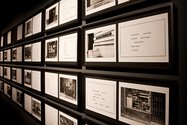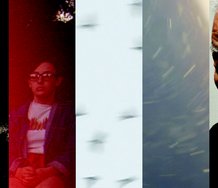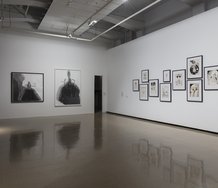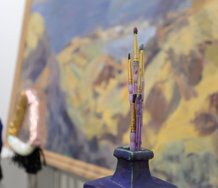Mark Amery – 2 November, 2012
I love how time enters this work. Usually in a photograph, action frozen by the shutter suggests a point in time. Here those markers are taken away. The architecture represents a variety of periods of New York’s history, signs are peeling and fading, and the contents of shop windows provide conversations between the present and the past.
Wellington
Martha Rosler
The Bowery in Two Inadequate Descriptive Systems
23 October 2012 - 10 February 2013
Martha Rosler’s dancing list of words for being drunk unsettles an orderly view of the images they are paired with - New York Bowery district shopfronts circa 1975. Together they suggest that all is at sea, unwell. We might now add with hindsight that society itself is drunk. It has overindulged. Smashed, it is reckless and not fully conscious of the way it is littering the world. Blotto, it’s no longer really capable of looking after itself.
Analogies with the current moment in time are inevitable and a good indication of the work’s seminal power. Take an image of two empty bottles on a vacant pedestal at the entrance to the First National City Bank. It is paired with a gamboling series of words: ‘plastered, stuccoed, rosined, shellacked, vulcanized, inebriated, polluted’. Received images of Occupy Wall Street 2011 immediately spring to mind.
Geoffery Batchen of the art history department at Victoria University considers Rosler’s The Bowery as being a ground-zero point of reference for documentary photography since the 1970s. The work (an edition of five) is to be found in the collections of the San Francisco Museum of Modern Art and the Whitney. It appeared in Documenta 2009. I am told this set is from a New York dealer.
The themes of this work remain pertinent today. Despite the use of black and white photography, cardboard backing board and a language-poetry redolent of the 1970s the work feels remarkably fresh.
Created at a time when New York and in particular the Bowery were notoriously derelict (and the scene of an exciting emerging popular culture), The Bowery features 21 photographs paired with texts, and a further three texts at the top left of the grid-layout where images on the shared white field on black backing are absent.
There are over a hundred expressions or euphemisms for being drunk placed often with a beautiful attention to their visual poetry with each other. The images are straight-on shots of shop fronts and fences around the neighbourhood, most shot at a fairly even distance to ensure we pick up the pavement below and its collected detritus. That this is a formal, objective modernist documentary stance however is undermined by the text and poetic (i.e. subjective) selection and arrangement of the images.
The absence of three images in the top three pairs assists in giving the work a book layout feel. It might be engineered to suggest vacancy or provide rhythm, but makes no immediate sense to me. There is also a progression through the texts from words that are more lifeaffirming to those that allude to death. All this might encourage you to read the work as a left to right, top to bottom sequence, but having had my brain rewired by internet use I find myself rejecting this. Rather, laid out in a grid with a lack of clear narrative I am more compelled to move (woozily? drunkenly?) around the whole surface. This tension is one weakness of this work, although it must be said that its great achievement is on every level to always resist one strict reading, echoing the ‘inadequacy’ of the title. Like all great work most attempts to summarise its reading are met by an ‘and yet…’. I love how as art it embraces uncertainty.
As the title also outlines, there are two parallel ‘inadequate descriptive systems’ being employed here. Rosler underlines how neither text nor image can adequately represent the experience of something.
In almost every photograph an empty spirit bottle or two may be seen, along with other traces of vagrant activity. This focus on the evidence of human activity, rather than on the human figure itself remains for the documentary tradition interesting. Its presentation here remains charged, not old hat. In each image it is daylight but all doors and gates are closed and/or shuttered. We are denied access to the warm interiors and their social spaces. Rather than voyeur we become one of the homeless.
At a time when the Dominion Post is reporting evidence that homelessness is on the rise (surprise, surprise) the work is timely. It puts up shutters ‘and yet’ provides dignity and humanity to its subject (and what an interesting expression is subject with this work). It speaks powerfully to how homelessness and alcoholicism remain issues we’d rather not think about. The elevation of the words to poetry brings the issues of the street into high culture (compare to the reverse act of graffing in the street itself).
Placed alone in the windowless Kirk gallery, lit strongly on the far wall in darkness, the presentation is almost shrine-like. The work is given space to breathe, and the visitor passage for reflection.
I love how time enters this work. Usually in a photograph, action frozen by the shutter suggests a point in time. Here those markers are taken away. The architecture represents a variety of periods of New York’s history, signs are peeling and fading, and the contents of shop windows provide conversations between the present and the past. A pair of old fashioned cash registers sits in a window upon which is placed a sign advertising electronic calculators.
I’m reminded that it is in a downturn that history is most visible. The detritus on the ground represents a tidal flow. I find myself thinking of the timelessness of Atget’s images of Paris a century ago, or in Wellington and Whanganui recently the work of Andrew Ross. In these three artists’ work the camera becomes a repository for the collection of time within a physical site.
I often find experimental poetry exasperating - making nonsense of language’s core communicative function - yet here there’s an engaging rhythmic musicality to the way it is ordered visually in space. It frees up the interpretation of the photographs. It makes us aware of how the street and the shop window’s dressing themselves provide a play between the ordered and habitual.
The measuring of the use of language and space on the page is also at times, shall we say, sobering. In one pairing, spirit bottles collect around the bottom of a fence. The text next to it, in two rows at the bottom of the page reads ‘dead soldiers, dead marines’. Another image nearby features a ground level coal chute, as if through it bodies may have been swept like cigarette butts.
That Martha Rosler is set to participate in the inaugural Adam Art Gallery Skype Conversation series in early 2013, “discussing politics, activism, and the digital commons in the context of her recent projects” excites me no end.
Mark Amery



 Advertising in this column
Advertising in this column Two Rooms presents a program of residencies and projects
Two Rooms presents a program of residencies and projects



This Discussion has 0 comments.
Comment
Participate
Register to Participate.
Sign in
Sign in to an existing account.